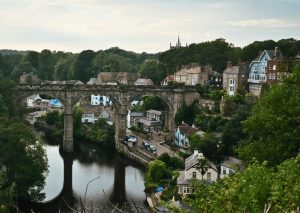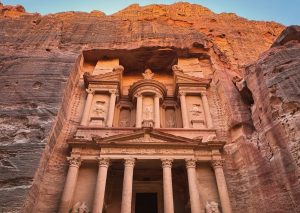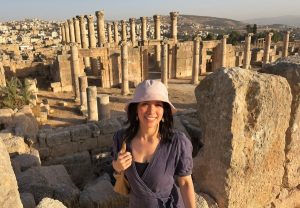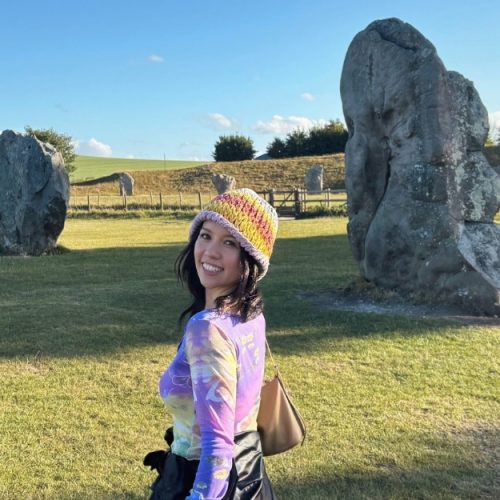
For years I often found myself dreaming of visiting Angkor Wat and finally, this year, my dream came true. What I didn’t realise, however, is that there are many more temples to explore beyond Angkor Wat all within close proximity to each other.
It’s a whole complex – much bigger than most people probably imagine. It’s a sprawl. A vast, tangled city of ancient stone that once housed the spiritual and political heart of the Khmer Empire.
Ancient Angkor – much more than just one temple
Most people come for Angkor Wat, but they stay to see the rest of the Angkor. During the reign of the Khmer Empire, Angkor was one of the largest and most sophisticated urban centres in the pre-industrial world. From the 9th to the 15th century, it thrived with advanced hydraulic engineering, grand avenues, and monumental stone temples carved with celestial dancers and epic battle scenes.
But what makes it truly special isn’t just its size or beauty. It’s that Angkor survives. Despite centuries of jungle, war, looting, and weather, these temples still stand – moss-covered, cracked, and utterly majestic.

Which Angkor temples should you visit?
There are over 70 major temples in the Angkor Archaeological Park, and hundreds more smaller shrines, structures, and ruins scattered throughout the broader Angkor region.
Some estimates, depending on how you define a “temple,” push the number to well over a thousand – if you include every collapsed brick structure, minor sanctuary, and hidden corner where jungle roots now hold court. Many are unnamed, undocumented, or still partially buried by jungle. Needless to say, it would have been impossible to see anywhere close to that number across the six days I spent in and around the complex.
I probably visit around twenty or so temples, and I honestly loved them all, Angkor is without doubt one of the most incredible UNESCO World Heritage Sites the world has to offer. Each one tells a different story, blending Hindu and Buddhist iconography, political ambition, and deep spiritual belief. I really got the impression that I wasn’t just looking at ruins – I was standing in the remains of a lost civilisation. A place where intricately carved stone hold meaning long after its kings have fallen.
Before heading to Angkor, I was a bit concerned that it might feel like a circus of sorts with so many tourists. While there’s no denying that some temples are very busy such as Angkor Wat, Bayon, and Ta Prohm, you can also visit lesser-known temples where less people venture.
In this list, I’ve put together a mix of temples that are both popular and less visited to give you the opportunity to escape the crowds. It should go without saying, the earlier you visit, and the further away you venture from Angkor Wat, naturally the crowds begin to disperse.
So without further ado, here are my favourite Angkor temples:
1. Angkor Wat

Why visit? It’s the world’s largest religious monument.
Built in the early 12th century by King Suryavarman II as a Hindu temple to Vishnu, Angkor Wat is more than just a postcard. It’s the largest religious monument on Earth. This place is power, carved in stone, and it was never meant to be subtle. Its politics, religion, and legacy rolled into one massive declaration of ambition.
Yes it will be busy, but for good reason. The level of craftsmanship is staggering. Every square inch seems to have been etched with purpose – from the delicate Apsara dancers frozen mid-twirl on the walls to the elaborate bas-reliefs depicting scenes from the Ramayana and Mahabharata.


You don’t just walk through Angkor Wat, you swim in a sea of sandstone storytelling, each figure chipped by hand, by men who probably died long before the final tower was complete.
Come at dawn. Yeah, it’s cliché. But when those five towers claw out of the darkness and the sky bleeds from violet into gold, you’ll forget about how tired you are. The crowds don’t matter. The magic still works.
Don’t miss: The Battle of Kurukshetra, carved over 800 years ago, stretches out like a fever dream of war and destiny. Limbs locked in combat, horses twisted mid-charge, gods hovering above mortals like cosmic referees. It’s the Mahabharata — India’s great epic of blood, honour, and fate – transplanted into Khmer hands, retold in sandstone, every detail sharp and bold.
2. Bayon

Why visit? It’s the temple with giant stone faces.
If I had to pick a temple based purely on aesthetics, I think Bayon might win the competition. The beautiful yet slightly creepy heads protruding from the temple is a vision I won’t forget.
Built a century after Angkor Wat by Jayavarman VII, it was the king’s Buddhist answer to Hindu dominance – a fusion of spiritual ambition and imperial pride. There are 54 towers and over 200 giant stone faces, all smiling that same cryptic smile – part Buddha, part trickster, part guy who knows how this all ends.
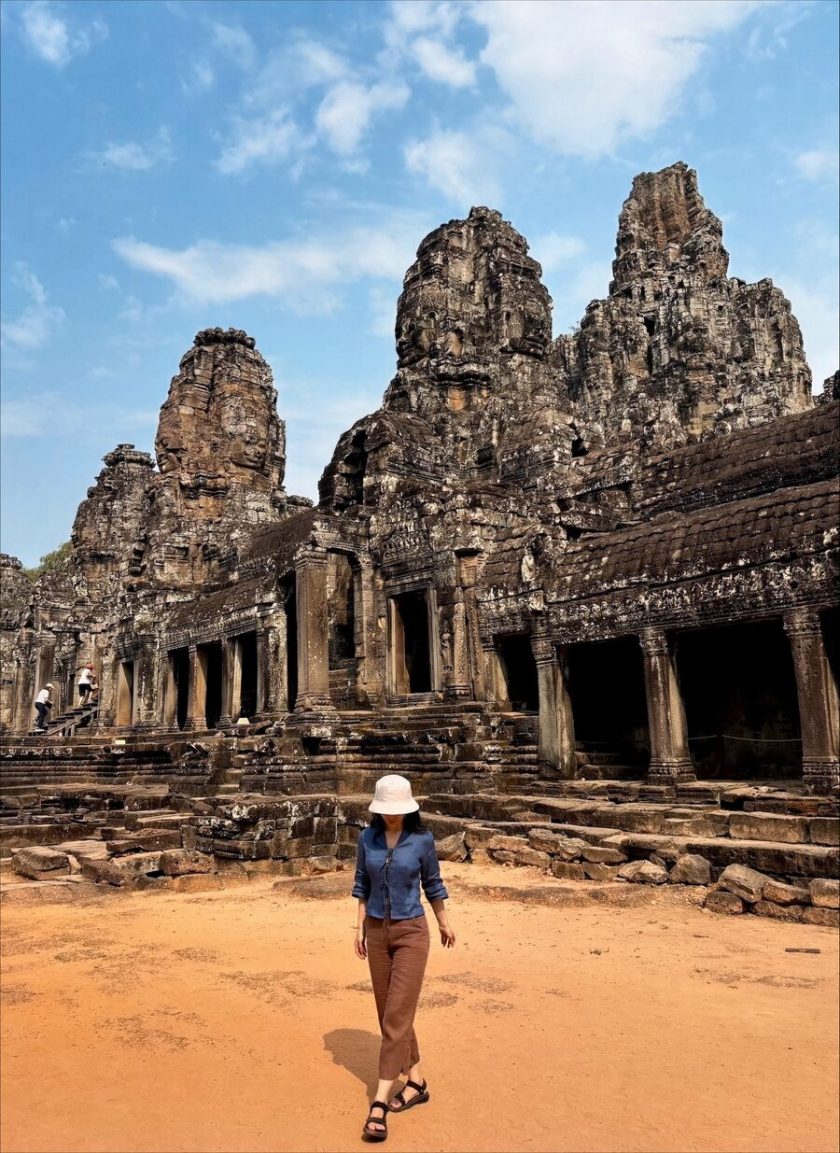
If the Mona Lisa were a temple, she’d be Bayon. All these stone heads looming over you with a mysterious expression, and it’s a mystery how they ever got up there in the first place.
You’ll walk down a labyrinth of corridors that lead to dusty squares. Staircases that go nowhere. Shadows that shift as you turn corners. Wherever you go, there’s a feeling of being watched… though it’s not as sinister as it might sound.
3. Ta Prohm

Why visit? It looks like the movie set. Actually, wait, it was a movie set.
Ta Prohm is what happens when nature calls checkmate. Built in 1186, it was a monastery and university – one of the largest of the Angkorian era. Jayavarman VII dedicated it to his mother. That’s sweet. But what you’ll remember is how the jungle came back with a vengeance.
Roots thicker than your torso strangling doorways. Trees splitting open galleries like they’re cracking eggs. Entire walls shifted off their axis by centuries of creeping vines. It’s organic entropy, and otherworldly.
The original Khmer builders weren’t just architects — they were master masons, astronomers, artists. The blocks here are laid so precisely, many without mortar, that they’ve held despite being under siege by roots and time. And somehow, even in decay, it’s stunning.
Claim to fame: Ta Prohm served as the background to Tomb Raider (2001) with Angelina Jolie. I’ve still not seen the film, but after visiting, I’ve added it to my list of films to watch.
4. Preah Khan

Why visit? Roam freely down ruined corridors.
If you’re looking to escape the crowds, Preah Khan is typically quieter and less visited than the aforementioned. The thing just appears completely abandoned. Just long, shadowed corridors, crumbling doorways, and the low hum of a place that remembers more than it says.
Built in the late 12th century by King Jayavarman VII, Preah Khan was more than a temple. It was a city, a monastery, a university – a living, breathing sanctuary for worship and scholarship. Dedicated to his father, it was part of the king’s sweeping plan to rebuild the Khmer Empire not just in stone, but in spirit.
Now, it’s mostly ruin. And that’s the charm. However, among the ruins you can tell this would have been one of Angkor’s most impressive temples in its heyday Inside is a large stupa, and another point of interest is a linga that’s still very much intact. Around many of the temples, you will spot lingas, a phallic symbol of the Hindu god Shiva, and the one in Preah Khan is one of the most notable ones!
You walk through collapsed galleries, vines creeping over sandstone lintels, ancient guardian statues broken but still watching. The carvings here aren’t just decoration – they’re devotion, done by hand, in heat, in faith. Hindu gods sit beside Buddhist motifs, the two religions woven together like competing myths learning to share a roof.
Unlike Angkor Wat’s grandstanding or Ta Prohm’s jungle drama, Preah Khan is quiet resilience. It doesn’t scream. It endures. If you’re lucky, you’ll have a corridors to yourself. You feel the weight of it all in the stillness. The kind of silence that makes you think about the passing of history.
5. Phnom Bakheng

Why visit? Go for sunset – it’s the highest point of Angkor.
Climbing Phnom Bakheng isn’t elegant. The path winds uphill through the dust, under the jungle’s suffocating green canopy. You’ll sweat, but it’s okay, you’ve been sweating all day, so it doesn’t really make a difference. At the top, you are met with Angkor Wat in the distance, wrapped in gold and haze, and the jungle stretching out like an ancient, breathing sea.
The temple is built in a pyramid form of seven levels, representing the seven heavens. Once the clock strikes 6 pm, the guard ushers you to climb up. You sit on the edge of this 9th-century Hindu temple, built by King Yasovarman I as the centerpiece of his new capital, a temple-mountain designed to mimic Mount Meru, the spiritual axis of the universe in Hindu cosmology – home of the Gods.
Back then, Phnom Bakheng was the heart of power. Rituals. Offerings. Cosmic alignment. Now, it’s digital shutters and camera phones fighting for position as the sun sinks slow and theatrical behind the trees. And yet – yet – something still pulses here. Once the sun begins to fall, the crowd becomes silent, there’s a mutual understanding that the moment is precious.
6. Banteay Kdei
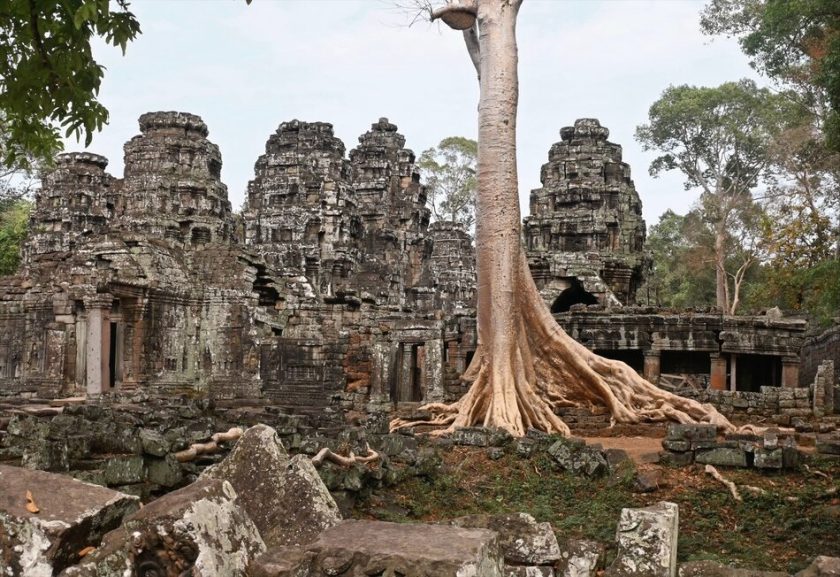
Why visit? Very atmospheric – for those who enjoy the ‘abandoned’ look.
Built in the late 12th century under King Jayavarman VII – the same guy behind Ta Prohm and Bayon – Banteay Kdei was a Buddhist monastery, a sanctuary for reflection. And you can feel that stillness in its bones. The name means “Citadel of Chambers,” and that’s exactly what it is: a labyrinth of cloisters and collapsing halls, held together by tree roots, dust, and memory.
The craftsmanship here has been worn down, softened by time and rain. But look closer, particularly in the “Hall of the Dancing Girls, and you’ll see dancing apsaras with knowing smiles, lions guarding doorways to nowhere, and lichen-covered pillars leaning like old monks in prayer. It’s imperfect — and that’s the charm.
There are no crowds. No circus. Just the occasional sound of footsteps but otherwise it’s peaceful. There are four entry points, each marked by an elaborate gateway known as gopura, displaying the same enigmatic face found on the gates of Bayon.
Don’t miss: The golden tree that looks almost mythical sitting looming at the back of the Southern side.
7. Banteay Srei

Why visit? Home to Angkor’s most intricate carvings.
If the main temples are about scale and legacy, Banteay Srei is about obsession. Built in the 10th century, this temple wasn’t commissioned by a king, instead by a courtier. It’s smaller, pinker, and intricately carved from red sandstone so fine it’s held its detail better than almost anything else at Angkor.
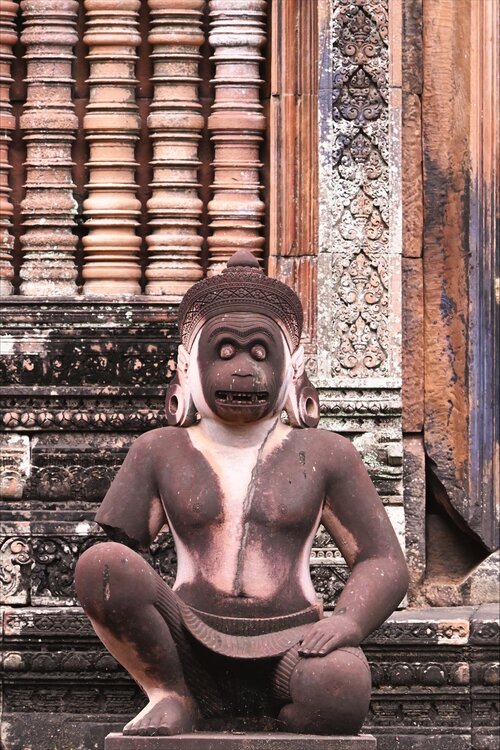

This place is a love letter to Shiva as well as artistry. The pediments above doorways are so delicate, so densely layered with mythic scenes and floral filigree, they almost look embroidered. You half-expect them to flutter in the breeze. This temple in particular reminded me of some of the stone-carved temples I visited in Tamil Nadu, India, and after some research I discovered that it’s believed that the ones in South India in fact influenced some of the designs found in Angkor.
Banteay Srei is out of the way – about 35 km from the main complex – but that’s what makes it worthwhile. The sparser crowds are also a bonus. It’s intimate, and a testament to what human hands can do when they’re driven by devotion rather than decree.
How to get there: It took me about 50 minutes to reach Banteay Srei from the centre of Siem Reap by scooter. Alternatively, you can also hire a tuk-tuk. There’s a large carpark and a great outdoor restaurant to fuel up on fish amok after you have finished exploring the temple.
Preparation for your visit to Angkor
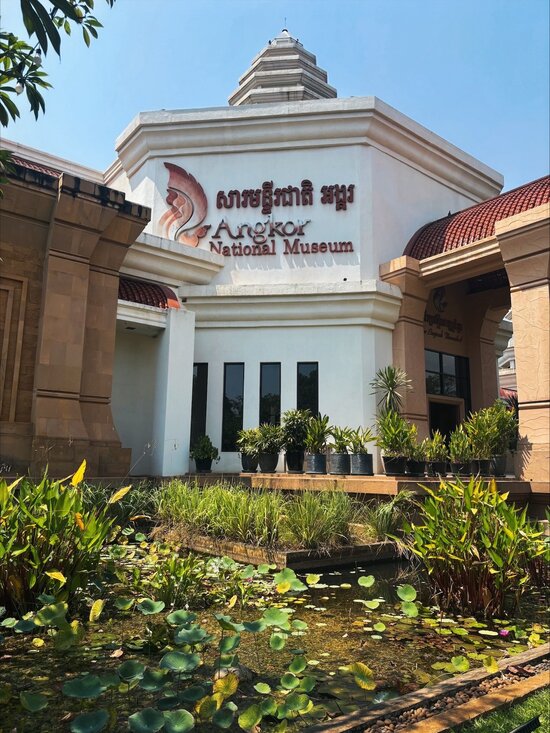
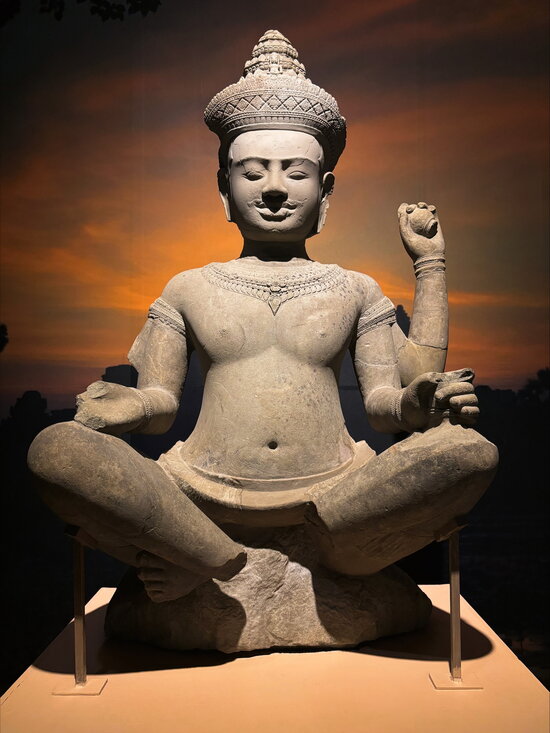
Before entering the Angkor complex, I visited Angkor National Museum in Siem Reap to get a better understanding of what I’d actually be looking at out there – the gods, the symbols, the stories half-lost in weathered walls.
The Angkor National Museum is sleek, air-conditioned, and surprising well-organised. I recommend paying a little bit extra for the audio guide which is a crash course in Khmer mythology, history, and divine ambition. You walk past entire galleries of Buddhas and other relics – heads of missing statues, fragments of temples that time didn’t spare – that tell the story behind the spectacle. The who, the why, the cost. This museum will 100% enrich you exploration of Angkor.
Optional tours of Angkor Wat and beyond
In addition, you can also book a guided tour of Angkor. There are many to choose from of various durations. If you’re in Angkor for a few days, you might want to book a tour for your first day, and then explore freely afterwards, revisiting some of the temples you wish to spend more time in again in addition to some lesser known temples.
If you’re not renting a moped, this personalised 6.5hr tour of Angkor includes hotel pick-up and drop-off via tuk-tuk.
Parting thoughts
You don’t just see Angkor. You get lost in it. You walk until your feet ache and your body is drenched in sweat. Bring a handheld fan and you can thank me later.


